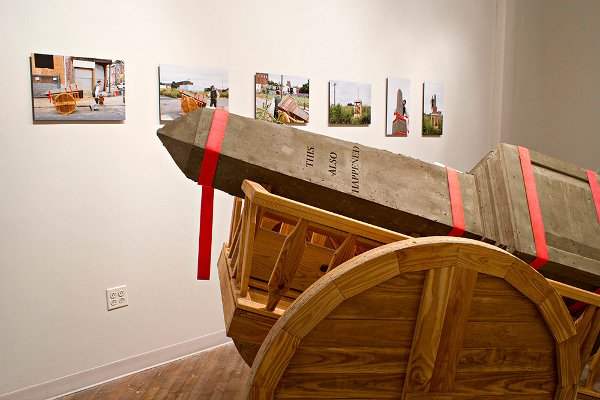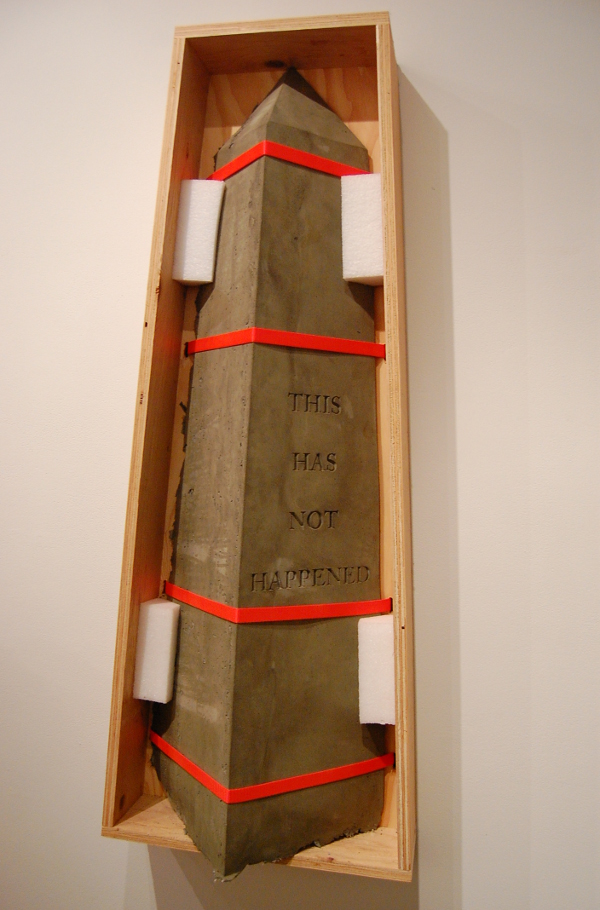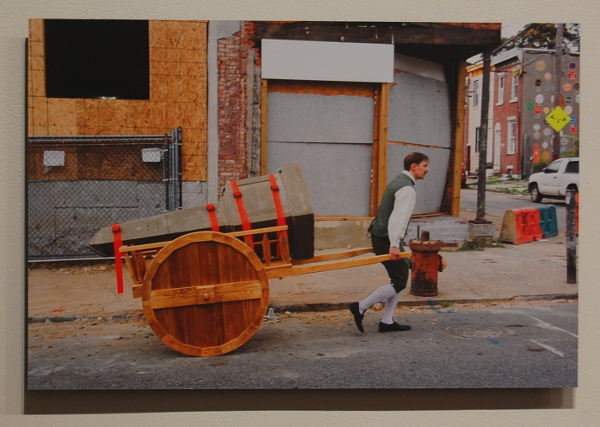
Lewis Colburn and the monumental task of commemorating everything and nothing at all
Lewis Colburn is the sort of historian that creates history. Through the images of antiquity and memorial that he harnesses to fabricate his show, “On This Site,” at Napoleon, Colburn departs on a monumental farce that is comical yet philosophically challenging. By recognizing the present as an integral step toward the narrative of historical hindsight, the artist allows himself to send a paradoxical parable into the annals of the future’s past.
The obelisk has a long history itself, built as far back as Ancient Egypt and eventually usurped by the Roman admirers who proliferated the form, and the Greeks from whom we take its name. Eventually the form of a tapered rectangular prism with a pyramid on top made its way into the Classical nostalgia of North America, with its tallest manifestation – the 555-foot-tall Washington Monument – residing in the District of Columbia.
Like a game of whisper down the alley, Colburn seems to note the contextual changes that come along with passing down an image through the filters of time and cultural nuance. Originally a symbol of the sun god Ra, the obelisk was much later reborn as an enormous tribute to the first United States President. Colburn is interested in how these transformations come to be, but also what they signify.
A shipping crate with part of a monument to something that has not happened.
History is largely an interpretation; it is composed of stories and accounts, not always hard scientific facts or numbers. While certain dates and facts are all but inarguable, there remains a certain ambiguity to the process of interpreting those things which no longer are. This openness far from clarifies the subject for minds that often crave order, and we are stuck with the dilemma of time itself. Grappling the past, especially not having been there, can certainly be daunting. This is to say nothing of the future…
In order to confront this epistemological behemoth, Colburn opted for yet another update to the longstanding vision of the obelisk. His monument lies on its side in a sturdy wooden cart, split in half at its edges and bearing the dueling inscriptions “THIS ALSO HAPPENED/THIS HAS NOT HAPPENED.” It is hollow, possibly so that its concrete and fiberglass structure is easily portable, and rests strapped to its wheeled companion with bright orange straps. Other segments of identical columns hang from the walls in shipping crates blurring the lines between historic original and mass-produced replica. Maybe the hollowness is indicative of something beyond its physical weight after all?
Lewis Colburn carts his complete monument through North Philadelphia.
On one wall, Colburn appears in a series of photographs taken as he lugs the monument through the streets of contemporary Philadelphia dressed in colonial garb. In a way this anachronism emphasizes that we all create history, whether we like it or not, and eventually the structure is installed in an overgrown field, dilapidated buildings visible in the background. Something has definitely happened here (a photo-op with a sculpture, at the very least), but what about the limitless other locations that have experienced events? What even defines an ‘event?’ Can a place truly hold lasting value?
While the obelisk could conceivably be erected anywhere, Lewis Colburn marks this particular spot.
Then of course we recall the flipside. “THIS HAS NOT HAPPENED.” Colburn’s history is less of an account and more of a placeholder. By utilizing the multi-faceted meaning of the obelisk, he slips seamlessly into the linear timeline that tends to pan out in traditional storytelling. But what if time is not linear? As statues erode and patina, we see that even the most stalwart achievements return to the earth. In this way, Colburn’s monument is also a reminder of all the places and things time has forgotten, and all of the untold events that occurred outside the sphere of human observation or understanding.
Recalling both everything and nothing is an undertaking that can make any mind or monolith seem minuscule, but Colburn manages to squeeze the infinite into a time-tested geometric marker that is more symbol than substance. Will this monument ever find its way to another place? Only time will tell. “On This Site” will run through November 25.
Napoleon is located at 319 North 11th St., on the second floor, Philadelphia; [email protected]; napoleonnapoleon.com.
Recent Content
-
Artsarticle ·
-
Artsarticle ·
-
Artsarticle ·



